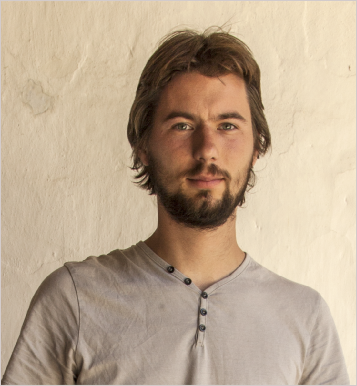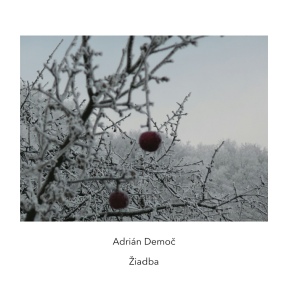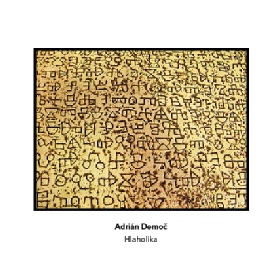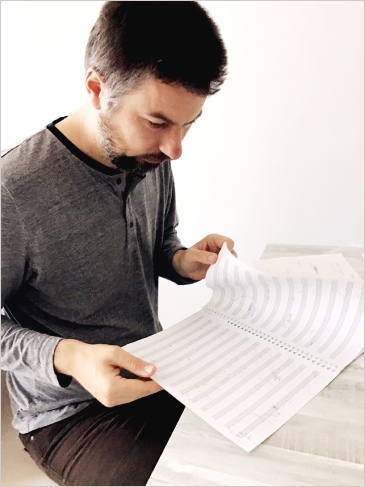Another Timbre TimHarrisonbre
Slovak Radio Symphony Orchestra, conducted by Marián Lejava
2. ‘Popínavá hudba’ (2022) 26:30
Ostrava New Orchestra, conducted by Petr Kotik
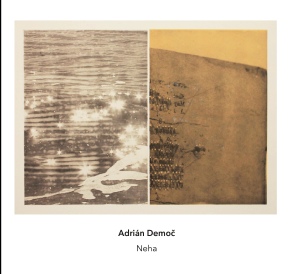
Let’s start with the first piece on the CD, ‘Neha’. What does the title mean, and why?
‘Neha’ is the Slovak word for ‘tenderness’. As both a listener and a composer I tend to prefer gentle and soft, non-violent music (I mentioned this in our first interview when the CD ‘Ziadba’ was released, and it’s probably clear from my music). But I’m also always searching for different shades, possibilities and discoveries within this very broad category. So ‘Neha’ is a piece in which there is no fighting or screaming. Rather, we listen to constantly returning chords, pitches, silence. I somehow felt that by gradually removing all the ‘unnecessary’ elements, I was composing naked music. Naked tenderness (in Slovak it almost sounds like word-play – “nahá neha”). And by the way, the name Neha also refers to a beautiful film by the Slovak director Martin Šulík.
Contemporary and experimental composers don’t often get the chance to write for orchestras. How did ‘Neha’ come about?
The piece was commissioned by the Czech Philharmonic as result of a competition for composers under 40. This was the second time that they had run this competition, and on this occasion it coincided with the first centenary of the creation of Czechoslovakia, so they decided to allow Slovak composers to participate as well. After many unsuccessful attempts in previous competitions, I sent the materials without any expectations, but, to my surprise, I was selected as one of the three finalists who were asked to write a new piece (the second part of the competition consisted in them judging the works before the actual performance and ‘Neha’ got the third prize). I didn’t want to write an exuberant fanfare-like celebration of the centenary, or to show off my “skills” in the competition. The piece I wrote is more likely to evoke a rather nostalgic feeling, although it is obviously not programmatic music.
I dedicated the piece to my ‘Czech friends whom I love’, as Slovak writer Dominik Tatarka would say. Without them, my music would have developed completely differently.
Was ‘Neha’ the first orchestral piece you’ve written? And if so, were you at all worried about having your music played by orchestral musicians rather than musicians specialising in contemporary or experimental music?
‘Neha’ is my third piece for symphony orchestra. The first was a piece called simply ‘Symphony’ which I wrote as my Master degree final work in 2007/2008. The piece was then performed by Moravian Philharmonic Orchestra Olomouc in Brno, Czech Republic. Composition students there have this nice opportunity in that their final orchestral work is usually performed.
A couple of years later, in 2013, I wrote a piece called ‘Selbstporträt mi Sikorski und Górecki (und Ligeti ist auch dabei)’. It was written at a time when I had just moved to Spain, and I was continuing to write music in spite of the fact that I didn’t really have anyone to write for, as I didn’t have any contacts there and had lost my physical contact with my fellow students and friends from Brno. So I wrote a piece for orchestra, quite utopian, with an individual scordatura for each string player, 1/6 clusters etc. The piece still hasn’t been performed. And during all these years I’ve also been studying orchestration by myself. I have also written several pieces for string orchestra, so I’ve got some experience with writing for larger ensembles.
I wasn’t really worried about having my music played by orchestral musicians. I did my best to make everything in the score and parts as clear as possible, and also did my best in trying to explain my vision to the conductor and players during the rehearsals. Obviously, there’s much less time during rehearsals with an orchestra, so the ideas must be presented and verbalised in a clear and simple way.
In the case of ‘Neha’ I wrote down these ideas for the conductor and the musicians just before the concert, and asked the players to pay attention to the following issues (I’m quoting from the score now):
The composition uses relatively simple harmonies, and the entire musical plot takes place at quiet dynamic levels, even at moments when the orchestra is playing tutti. Therefore, each note and chord must be played with enormous tenderness - quietly, softly, delicately. It is extremely important to maintain the necessary calmness and concentration throughout the duration of the whole piece.
Relatively consonant ‘known’ chords are used, but the whole thing happens beneath this surface. For example, these ‘well-tempered’ (and ‘well-known’) chords are doubled, or played in unison with, the same chords but using natural harmonics outside of the tempered tuning system. This doubling creates a gentle trembling of interferences, which adds a special acoustic quality, and, subjectively speaking, some kind of nostalgic ‘tenderness’. This ‘trembling of interferences’ should be audible from the very beginning of the piece.
By the way, I wasn’t able to be present at either the rehearsals or the concert for the second performance of ‘Neha’ by the Slovak Radio Philharmonic Orchestra, but I think Marián Lejava, the conductor, did a great job. We chose that performance for the CD.
And what about ‘Popínavá hudba’? What does that mean?
Any translation is rather problematic: ‘hudba’ means ‘music’, but ‘popínavá’ is a Slovak word referring specifically to the growth of climbing plants, for which there is no English equivalent. ‘Climbing music’ might be alright, except that the piece has nothing whatsoever to do with mountaineering, nor with going up trees, ladders or stairs.
How did the piece come about?
It was written for the Ostrava New Orchestra, an international symphony orchestra for new music created by the ‘Ostrava Center for New Music’ for the ‘Ostrava Days’ festival and other projects run by them. I was a participant at the Ostrava Days institute for composers in 2015 and 2017, and it seems that my music was noticed by the organisers who asked me to write this piece for a concert called ‘Essential Youth’, consisting of 5 premieres by young(er) composers (between ages of 24 and 41). So I’m very thankful to the Ostrava Center for the opportunity and trust they’ve placed in me.
I find it a really seductive bit of music, but how does it work?
The compositional method was rather simple: listening, again and again, immersion, attention. With humility and open ears. Getting rid of the unnecessary and doing my best to understand what this emerging music is about.
The piece works with a single melodic line (but I wouldn’t dare say the piece is about the melodic line). This line goes back and forth, often taking irregular shapes and curves. To me it resembles a climbing plant, hence the title. Technically speaking, the ‘skeleton’ of this melodic line is constructed upon a basis of a duo of double bass and cello (playing only natural harmonics), but this detail isn’t of a big importance for the listener.
There are a couple of other things here, too: a cluster, a simple but ever-changing shading of the melodic line, and a few sounds I´ve never used before, some of which appeared to me while dreaming.
Inevitably early commissions tend to be for small ensembles, and I know that some contemporary composers struggle when asked to write for orchestra. You seem to handle the transition very well, but do you enjoy writing orchestral music, or do you prefer the intimacy of chamber music?
Yes, I do enjoy it, although it’s obviously a lot of extra work, too (especially with the parts and notation and design of the whole score), and the possibilities of future performances of any orchestral piece are usually quite limited. But I find it intriguing to, for example, search for the intimacy you mention within an orchestra and thus convert it as an interesting paradox, a compositional task – how to achieve intimacy with, let’s say, orchestral tutti? Then there are other things, for example the possibility of creating situations you can only create when you have a certain number of people, or different timbres etc. Or even a supposedly simple question of balance or orchestral heaviness/lightness. So there’s a possibility of many threshold situations which I find very inspiring.
So I can’t really say which I prefer (although I’m tempted to say that a chamber situation would win). Looking back, I think both experiences are deeply connected. In other words, my way of composing actually does stay the same. And perhaps the two mutually enrich each other. That’s why, for me, ‘Neha’ is very connected with pieces such as ‘Modré kvety’ or ‘A Luca Marenzio’ (focused more on verticality, chords), while ‘Popínavá hudba’ shares more similarities with newer pieces focused on (imperfect) unison, such as ‘Hudba (Za názvom)’ or ‘Sen’. All this wasn’t calculated beforehand, but arose directly from the writing process.
And there are also details and (for me) huge discoveries from my chamber pieces which I used in the orchestral sound as well, for example practice mutes for brass or oboes (‘A Luca Marenzio’, ‘Modré kvety’), natural harmonics, etc. On the other hand, ‘Neha’ was my first piece that’s longer than 20 minutes, and this experience helped me to go further with my chamber music and write pieces such as the hour-long violin solo ‘Dotyky. Za zrkadlom’.
But I feel I’ve been very lucky in these last years, having the possibility to work with orchestral, solo musicians and chamber ensembles, including instruments from folk music or the world of early music. So I feel really happy to be able to keep composing, be it solo, chamber or orchestral music.
